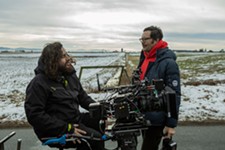The Way We Watch Now
Is theatrical-on-demand the next big thing?
By Richard Whittaker, Fri., June 22, 2012
(Page 2 of 2)
It's the communities that make the model work, and there are early signs that cause-driven documentaries like Incendiary may have a head start over other genres. After all, they're not just appealing to casual film fans; if they can tap into local pressure and interest groups, that's a whole new hungry audience. That phenomenon is not restricted to Tugg; Roller Derby documentary Derby, Baby! offered screenings as part of a reward for their Kickstarter campaign and ended up with 150 screenings in 160 cities, mostly run by derby leagues. Or, take education doc Race to Nowhere: By reaching straight out to parent and teacher groups around the nation, the filmmakers have organized 4,000 screenings so far.
Tugg had a similar experience with eco-doc One Day on Earth. The filmmakers wanted to launch in 11 cities on Earth Day, but, according to Gonda, the D.C. screening "was somewhat struggling." The promoters needed to confirm 80 presold tickets to lock in the screening, but had less than 20 people signed up. Says Gonda, "The film team approached a local environmental organization that had a mailing list of over 5,000 followers within the DC area. For them, this is exactly the kind of film that their group has been looking for and has been forced, until now, just to watch online. So without any financial incentive, they did it as a service to their community. They sent out an email blast to 5,000 people in their community, and within the next two days that event was nearing sell out."
Gonzalez has been surprised about which promoters are the most successful. It's not the big-name bloggers and Tweeters with thousands – or even millions – of followers. What works for Tugg, he says, are "influencers at a local level, with an email list of 500 people that could convince over 40 to 50 percent of them to go to a theatre on a Tuesday night and see a movie."
Tugg is not the only company innovating the TOD model. Like Gonda and Gonzalez, Gathr founder Scott Glosserman was frustrated by how the current distribution model worked. His debut feature, 2006 horror mockumentary Behind the Mask: The Rise of Leslie Vernon, got limited theatrical distribution – but that was more about getting quotes from New York and L.A. critics on the DVD box than getting asses in seats. Solving real theatrical exposure was a puzzle for Glosserman, and the key that opened its lock was his 2010 documentary Truth in Numbers? Everything, According to Wikipedia. "Wikipedia was simply a MySpace or a Facebook where the topic du jour was knowledge. But behind Wikipedia was a group of like-minded individuals who were aggregating themselves around something," says Glosserman. Add the microfinance model spearheaded for charities used by Kiva and seemingly perfected by Kickstarter and, he notes, "The whole thing was pointing to, 'well, we can do this for film – we can do this for theatrical releases.'"
The real game changer for TOD was Paranormal Activity. That movie sat on Paramount's shelves for a couple of years until director/producer Oren Peli borrowed the Eventful model – commonly used by bands to gauge local interest before scheduling a tour – for their publicity campaign. The only way you get to see the film, the commercials said, is if you demand it. Says Glosserman, "Despite the fact it was contrived, they were nevertheless driving at this notion that people could vote on where they wanted to watch the film, and then Paramount [Pictures] would service that."
Was that real electronic democracy, or just brilliant hucksterism? Either way, it accelerated a zero-budget indie horror film into a $200 million-grossing, sequel-spawning success. For Glosserman, the genius of the campaign was that it understood what plagues the movie business: too much material, too readily available. "The exhibition industry model was built on scarcity and for 80-some odd years, it was all about that, that the only place you could see it was in the theatres," Glosserman says. With the holdback window between theatrical and DVD releases collapsing, and some films turning up on video-on-demand even before they arrive in theatres, the thrill of the big Friday night opening is gone. Paranormal Activity brought back that scarcity factor, and Glosserman argues that distributors and cinemas need to learn from that. If distributors want the theatrical experience to survive, he says, "They've got to add premium content with it, whether they're making deals on food or items, or adding an expert to talk about a cause-driven documentary or doing Q&As."
It's that scarcity model again, and it's not just about getting hold of rare prints. When Kevin Smith four-walled Red State, it was part of a complete evening with the director/raconteur, and that was what sold tickets. Tugg tries to ensure that every screening comes with some form of bonus content. For example, Bailey and Mims regularly travel with Incendiary for post-screening Q&As. Adds Bailey, "That dialogue is really the most fun part of it for us."
At the moment, Tugg is in the beta stage, vetting every promoter before they sign off on a screening, and very cautiously rolling out. After all, there are still a lot of unanswered questions about TOD. Can it reach enough critical mass to be a viable business model? What kind of films work best? Who make the best promoters? And will promoters ever get more than just good vibes from a sold-out screening? All Gonda knows for certain is that there's a demand for TOD, "The hunger and appetite and interest in so many places already exists. It just needs to be empowered and armed."










